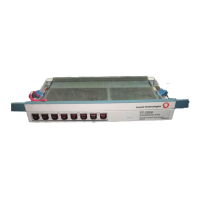Applications
Issue 8.0 July 2002
2-49
The message DUS (Don’t Use for Synchronization is used to indicate
■ a link on which timing has been looped back, in order to prevent timing
loops
■ an invalid message
Synchronization messages are exchanged
■ between FT-2000 nodes over OC-48 interfaces via bits 5, 6, 7, and 8 of the
S1 byte
■ from FT-2000 nodes to DDM-2000 nodes over OC-3 and OC-12 interfaces
via proprietary message set on bits 1, 2, and 3 of the K2 byte.
On the OC-48 interface, synchronization messages are both transmitted and
processed. On the IS-3, OC-3, and OC-12 interfaces, synchronization messages
are supported in the direction to distribute timing to DDM-2000. The table below
show two ring environments available:
■ interoffice
■ customer location.
Table 2-3 explains ring environments and the use of synchronization.
Table 2-3. FT-2000 Ring Environments
IF the ring
environment is...
THEN the
synchronization is located
in... AND...
interoffice central offices with
BITS clocks
synchronization messages are not
needed.
loop (customer
location)
customer sites without
BITS clocks
DS1 output will be used to provide
timing to the equipment in the
customer location.
Note: if the timing is not traceable to
the timing network, insert DS1 AIS.

